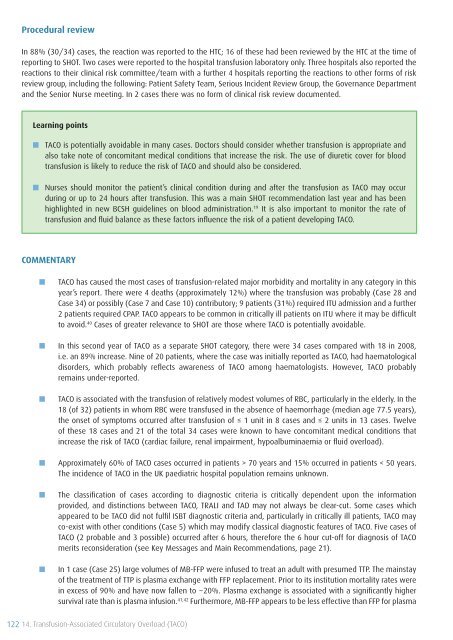SHOT Annual Report 2009 - Serious Hazards of Transfusion
SHOT Annual Report 2009 - Serious Hazards of Transfusion
SHOT Annual Report 2009 - Serious Hazards of Transfusion
You also want an ePaper? Increase the reach of your titles
YUMPU automatically turns print PDFs into web optimized ePapers that Google loves.
Procedural review<br />
In 88% (30/34) cases, the reaction was reported to the HTC; 16 <strong>of</strong> these had been reviewed by the HTC at the time <strong>of</strong><br />
reporting to <strong>SHOT</strong>. Two cases were reported to the hospital transfusion laboratory only. Three hospitals also reported the<br />
reactions to their clinical risk committee/team with a further 4 hospitals reporting the reactions to other forms <strong>of</strong> risk<br />
review group, including the following: Patient Safety Team, <strong>Serious</strong> Incident Review Group, the Governance Department<br />
and the Senior Nurse meeting. In 2 cases there was no form <strong>of</strong> clinical risk review documented.<br />
Learning points<br />
■■ TACO is potentially avoidable in many cases. Doctors should consider whether transfusion is appropriate and<br />
also take note <strong>of</strong> concomitant medical conditions that increase the risk. The use <strong>of</strong> diuretic cover for blood<br />
transfusion is likely to reduce the risk <strong>of</strong> TACO and should also be considered.<br />
■■ Nurses should monitor the patient’s clinical condition during and after the transfusion as TACO may occur<br />
during or up to 24 hours after transfusion. This was a main <strong>SHOT</strong> recommendation last year and has been<br />
highlighted in new BCSH guidelines on blood administration. 19 It is also important to monitor the rate <strong>of</strong><br />
transfusion and fluid balance as these factors influence the risk <strong>of</strong> a patient developing TACO.<br />
COMMENTARY<br />
■■<br />
■■<br />
■■<br />
■■<br />
■■<br />
■■<br />
TACO has caused the most cases <strong>of</strong> transfusion-related major morbidity and mortality in any category in this<br />
year’s report. There were 4 deaths (approximately 12%) where the transfusion was probably (Case 28 and<br />
Case 34) or possibly (Case 7 and Case 10) contributory; 9 patients (31%) required ITU admission and a further<br />
2 patients required CPAP. TACO appears to be common in critically ill patients on ITU where it may be difficult<br />
to avoid. 40 Cases <strong>of</strong> greater relevance to <strong>SHOT</strong> are those where TACO is potentially avoidable.<br />
In this second year <strong>of</strong> TACO as a separate <strong>SHOT</strong> category, there were 34 cases compared with 18 in 2008,<br />
i.e. an 89% increase. Nine <strong>of</strong> 20 patients, where the case was initially reported as TACO, had haematological<br />
disorders, which probably reflects awareness <strong>of</strong> TACO among haematologists. However, TACO probably<br />
remains under-reported.<br />
TACO is associated with the transfusion <strong>of</strong> relatively modest volumes <strong>of</strong> RBC, particularly in the elderly. In the<br />
18 (<strong>of</strong> 32) patients in whom RBC were transfused in the absence <strong>of</strong> haemorrhage (median age 77.5 years),<br />
the onset <strong>of</strong> symptoms occurred after transfusion <strong>of</strong> ≤ 1 unit in 8 cases and ≤ 2 units in 13 cases. Twelve<br />
<strong>of</strong> these 18 cases and 21 <strong>of</strong> the total 34 cases were known to have concomitant medical conditions that<br />
increase the risk <strong>of</strong> TACO (cardiac failure, renal impairment, hypoalbuminaemia or fluid overload).<br />
Approximately 60% <strong>of</strong> TACO cases occurred in patients > 70 years and 15% occurred in patients < 50 years.<br />
The incidence <strong>of</strong> TACO in the UK paediatric hospital population remains unknown.<br />
The classification <strong>of</strong> cases according to diagnostic criteria is critically dependent upon the information<br />
provided, and distinctions between TACO, TRALI and TAD may not always be clear-cut. Some cases which<br />
appeared to be TACO did not fulfil ISBT diagnostic criteria and, particularly in critically ill patients, TACO may<br />
co-exist with other conditions (Case 5) which may modify classical diagnostic features <strong>of</strong> TACO. Five cases <strong>of</strong><br />
TACO (2 probable and 3 possible) occurred after 6 hours, therefore the 6 hour cut-<strong>of</strong>f for diagnosis <strong>of</strong> TACO<br />
merits reconsideration (see Key Messages and Main Recommendations, page 21).<br />
In 1 case (Case 25) large volumes <strong>of</strong> MB-FFP were infused to treat an adult with presumed TTP. The mainstay<br />
<strong>of</strong> the treatment <strong>of</strong> TTP is plasma exchange with FFP replacement. Prior to its institution mortality rates were<br />
in excess <strong>of</strong> 90% and have now fallen to ~20%. Plasma exchange is associated with a significantly higher<br />
survival rate than is plasma infusion. 41,42 Furthermore, MB-FFP appears to be less effective than FFP for plasma<br />
122 14. <strong>Transfusion</strong>-Associated Circulatory Overload (TACO)












